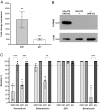Functional genetic validation of key genes conferring insecticide resistance in the major African malaria vector, Anopheles gambiae
- PMID: 31801878
- PMCID: PMC6926047
- DOI: 10.1073/pnas.1914633116
Functional genetic validation of key genes conferring insecticide resistance in the major African malaria vector, Anopheles gambiae
Abstract
Resistance in Anopheles gambiae to members of all 4 major classes (pyrethroids, carbamates, organochlorines, and organophosphates) of public health insecticides limits effective control of malaria transmission in Africa. Increase in expression of detoxifying enzymes has been associated with insecticide resistance, but their direct functional validation in An. gambiae is still lacking. Here, we perform transgenic analysis using the GAL4/UAS system to examine insecticide resistance phenotypes conferred by increased expression of the 3 genes-Cyp6m2, Cyp6p3, and Gste2-most often found up-regulated in resistant An. gambiae We report evidence in An. gambiae that organophosphate and organochlorine resistance is conferred by overexpression of GSTE2 in a broad tissue profile. Pyrethroid and carbamate resistance is bestowed by similar Cyp6p3 overexpression, and Cyp6m2 confers only pyrethroid resistance when overexpressed in the same tissues. Conversely, such Cyp6m2 overexpression increases susceptibility to the organophosphate malathion, presumably due to conversion to the more toxic metabolite, malaoxon. No resistant phenotypes are conferred when either Cyp6 gene overexpression is restricted to the midgut or oenocytes, indicating that neither tissue is involved in insecticide resistance mediated by the candidate P450s examined. Validation of genes conferring resistance provides markers to guide control strategies, and the observed negative cross-resistance due to Cyp6m2 gives credence to proposed dual-insecticide strategies to overcome pyrethroid resistance. These transgenic An. gambiae-resistant lines are being used to test the "resistance-breaking" efficacy of active compounds early in their development.
Keywords: GAL4/UAS; cytochromes P450; functional analysis; glutathione-S-transferase.
Copyright © 2019 the Author(s). Published by PNAS.
Conflict of interest statement
The authors declare no competing interest.
Figures




References
-
- World Health Organization , World Malaria Report 2018 (World Health Organization, Geneva, Switzerland, 2018).
-
- Ranson H., Lissenden N., Insecticide resistance in African anopheles mosquitoes: A worsening situation that needs urgent action to maintain malaria control. Trends Parasitol. 32, 187–196 (2016). - PubMed
-
- Hemingway J., Hawkes N. J., McCarroll L., Ranson H., The molecular basis of insecticide resistance in mosquitoes. Insect Biochem. Mol. Biol. 34, 653–665 (2004). - PubMed
Publication types
MeSH terms
Substances
Grants and funding
LinkOut - more resources
Full Text Sources

